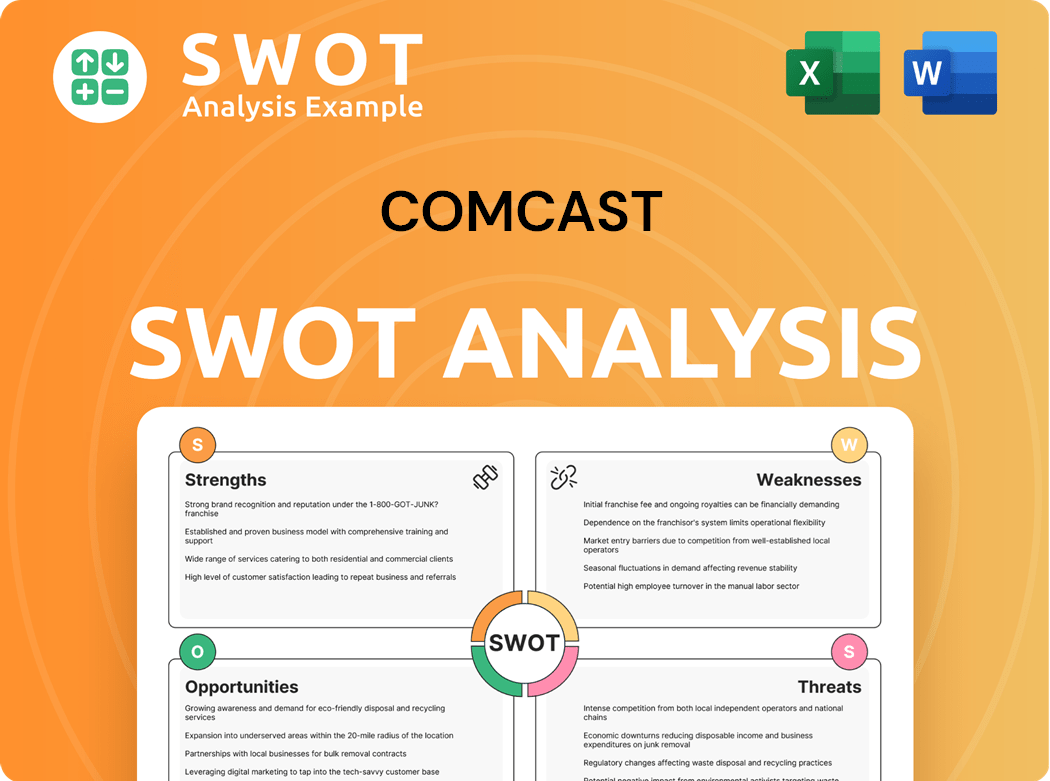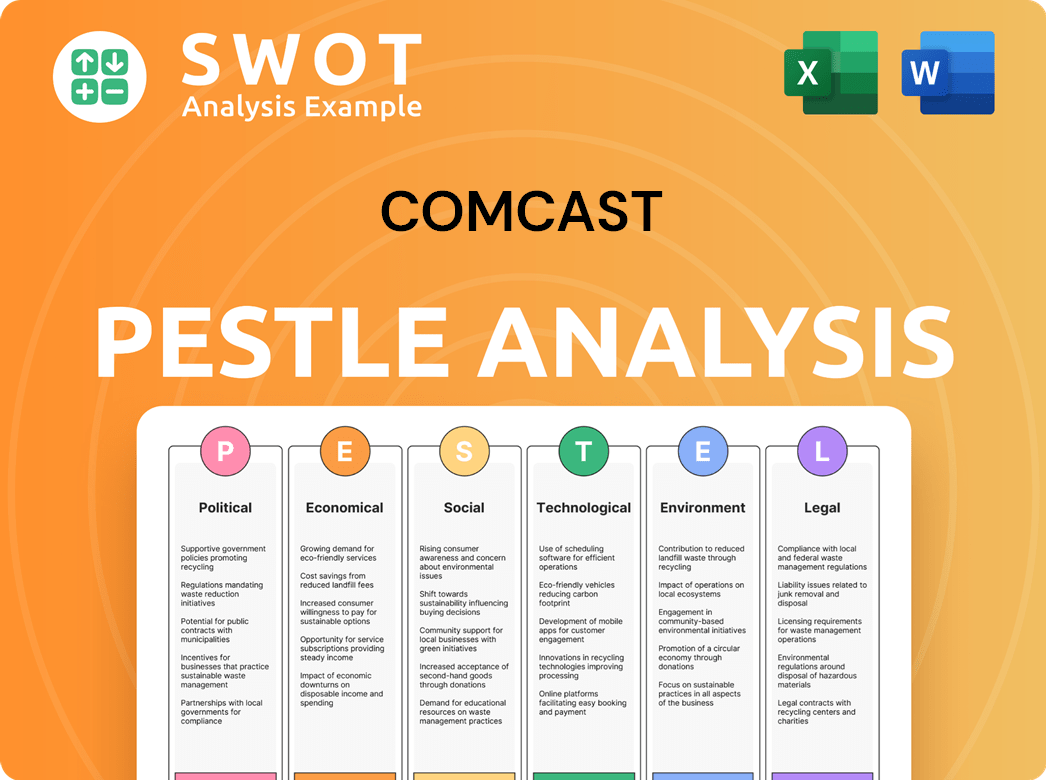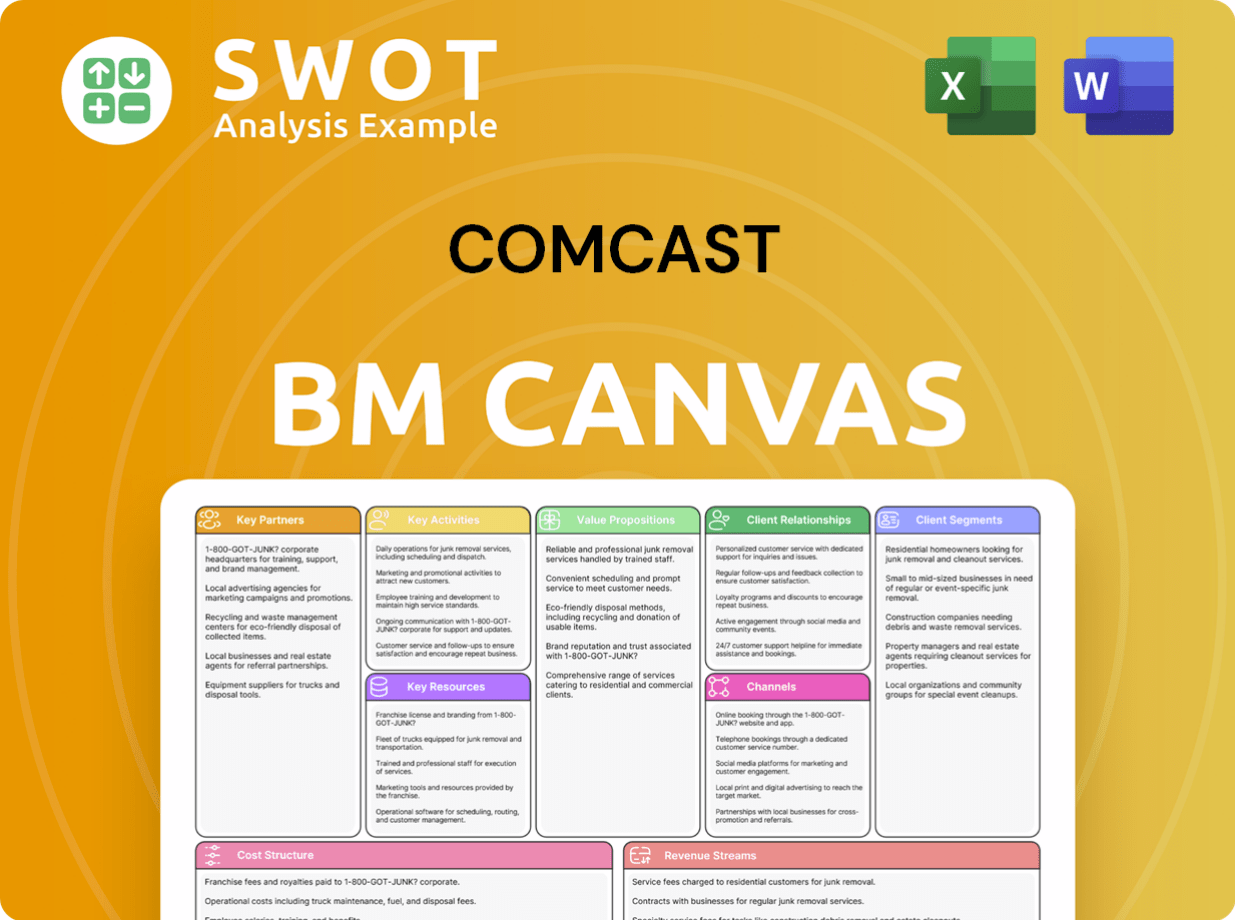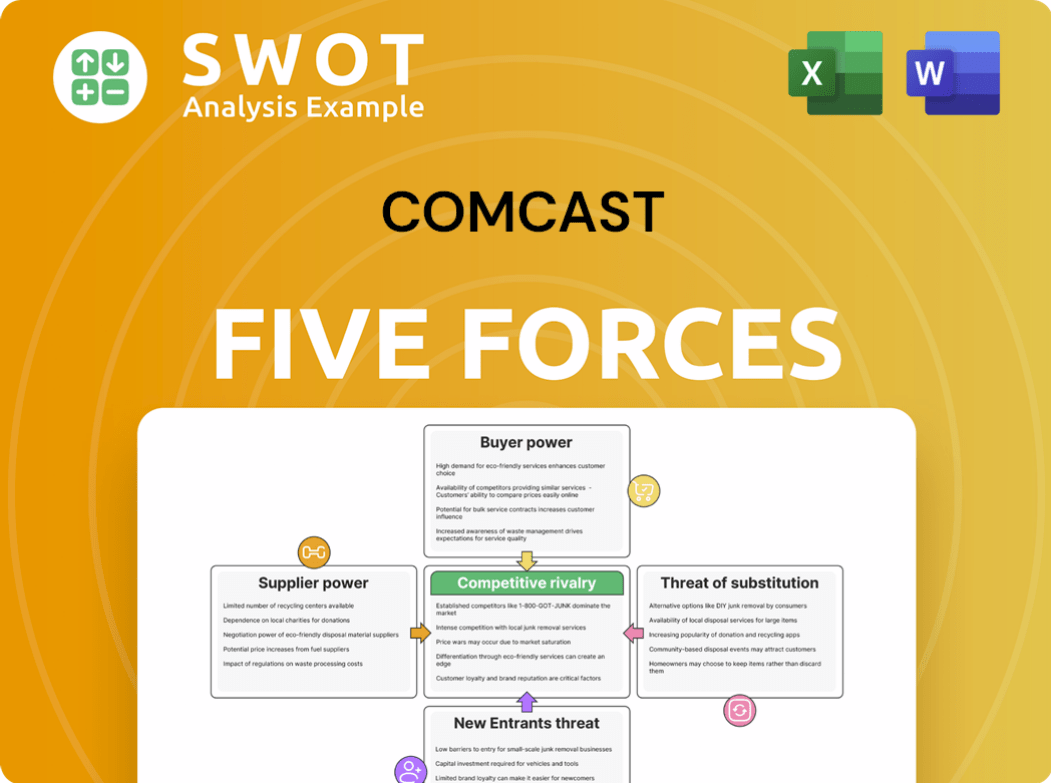Comcast Bundle
How Does Comcast Dominate the Telecom Battlefield?
Comcast, a titan in the media and technology sector, is constantly maneuvering within a dynamic competitive landscape. Its strategic focus on broadband and streaming services showcases its ambition to stay ahead of the curve. Understanding the Comcast SWOT Analysis is crucial to grasping its position in the market.

This exploration dives into the Comcast competitive landscape, examining its primary rivals and the strategies it employs to maintain its edge. We'll analyze Comcast's market share, compare it to Xfinity rivals like Verizon, and assess its competitive advantages in the cable industry competition. Furthermore, we'll investigate how Comcast responds to broadband providers and fiber optic competition, providing a detailed Comcast market analysis.
Where Does Comcast’ Stand in the Current Market?
Comcast holds a significant market position within the U.S. broadband and cable television industries. As of late 2024, its Xfinity brand is a leading broadband provider, serving a substantial portion of the residential internet market. Comcast's primary offerings include high-speed internet, video (cable television), voice (VoIP), and Xfinity Mobile, a mobile virtual network operator (MVNO) service. The company's footprint is primarily concentrated in the United States, with a strong presence in major metropolitan and suburban areas.
Comcast's market position is dynamic, shaped by industry trends and strategic shifts. The company has prioritized broadband growth amid a decline in traditional video subscribers, reflecting the impact of streaming services and over-the-top (OTT) content. Comcast has also expanded its enterprise services for businesses and made significant investments in its theme parks and film studios through NBCUniversal. Financially, Comcast demonstrates robust health, reporting total revenue of $30.1 billion in the first quarter of 2024.
The company's competitive landscape is constantly evolving. Comcast's ability to maintain and grow its market share depends on its response to competitive pressures, technological advancements, and changing consumer preferences. For more insights, you can explore the Growth Strategy of Comcast.
Comcast consistently ranks among the top broadband providers by subscribers in the United States. While specific market share figures fluctuate, the company maintains a significant presence. In the first quarter of 2024, Comcast reported 32.2 million broadband subscribers, demonstrating its strong market position.
Comcast's video subscriber base has experienced declines due to cord-cutting and competition from streaming services. This trend reflects broader changes in consumer behavior. Despite these declines, Comcast continues to generate substantial revenue from its video services, though its focus is increasingly on broadband.
Comcast's geographic footprint is primarily in the United States, with a strong presence in numerous major metropolitan areas and suburban regions. The company leverages its established infrastructure to deliver high-speed internet. This concentrated presence allows for efficient service delivery and competitive pricing in many regions.
Broadband continues to be a significant revenue driver for Comcast, partially offsetting losses from declining video subscribers. Enterprise services and NBCUniversal also contribute to the company's revenue. In the first quarter of 2024, Comcast reported total revenue of $30.1 billion, highlighting its financial strength.
Comcast's market position is influenced by several key factors, including competition from other broadband providers and the shift towards streaming services. The company's response to these challenges will determine its future success. Understanding these dynamics is crucial for analyzing the Comcast competitive landscape.
- Broadband Competition: Competition from providers like AT&T, Verizon, and regional players.
- Cord-Cutting: The ongoing trend of consumers canceling traditional cable subscriptions.
- Streaming Services: The growing popularity of streaming services like Netflix, Disney+, and others.
- Technological Advancements: The impact of fiber optic technology and 5G on broadband speeds.
Comcast SWOT Analysis
- Complete SWOT Breakdown
- Fully Customizable
- Editable in Excel & Word
- Professional Formatting
- Investor-Ready Format

Who Are the Main Competitors Challenging Comcast?
The Comcast competitive landscape is shaped by a diverse group of rivals across its various business sectors. Understanding these competitors is crucial for a thorough Comcast market analysis. This analysis helps in evaluating the company's position and strategies within the dynamic telecom and media industries.
Comcast competitors range from traditional telecommunications giants to emerging tech companies and streaming services. The competitive environment is constantly evolving due to technological advancements, shifting consumer preferences, and strategic mergers and acquisitions. Keeping up with these changes is essential for investors and industry analysts.
In the broadband and cable communications sector, Comcast's most significant direct competitors include AT&T, Verizon, and Charter Communications (Spectrum). These companies compete directly with Xfinity for customers seeking internet, video, and voice services. The competition often involves pricing, speed, and service bundling.
AT&T is a major competitor, particularly with its fiber optic and 5G fixed wireless offerings. AT&T competes with Comcast on speed, reliability, and bundled services. AT&T's expansion of fiber optic infrastructure directly challenges Comcast's dominance in certain markets.
Verizon also poses a significant threat, especially with its growing fiber optic and 5G home internet services. Verizon competes with Comcast by offering high-speed internet and bundled services. The competition between Comcast and Verizon is intense in areas where both companies offer fiber-optic services.
Charter Communications, operating under the Spectrum brand, is another major cable operator that competes head-to-head with Comcast. Charter competes with Comcast in overlapping markets for broadband, video, and voice services. The competition often leads to price wars and promotional battles.
T-Mobile and other wireless carriers are increasingly offering 5G home internet, providing a compelling alternative to wired broadband. These providers compete with Comcast by offering wireless home internet services. The expansion of 5G coverage has made wireless internet a viable option for more consumers.
In the streaming content arena, NBCUniversal (owned by Comcast) competes with Netflix, Disney+, Max (Warner Bros. Discovery), and Amazon Prime Video. These platforms compete for consumer attention and subscription revenue. The streaming market is highly competitive, with exclusive content driving subscriber growth.
Mergers and alliances, such as the proposed merger between Warner Bros. Discovery and Paramount Global, could reshape the competitive dynamics in the media content space. These mergers create larger content powerhouses. The consolidation in the media industry increases competition for Comcast's NBCUniversal.
The cable industry competition is intense, with companies constantly innovating to attract and retain customers. For example, in Q1 2024, Comcast reported a net loss of residential video customers, while focusing on expanding its broadband and wireless services, according to recent reports. This highlights the challenges Comcast faces in maintaining its market share. For a deeper dive into Comcast's business model and its competitive positioning, you can read more about it in this article on Comcast's business model.
Several factors drive the Comcast competitive landscape, including technological advancements, pricing strategies, and content offerings. Understanding these dynamics is crucial for evaluating Comcast's future prospects.
- Fiber Optic Expansion: AT&T and Verizon's aggressive fiber optic deployments directly challenge Comcast's cable broadband dominance.
- 5G Home Internet: Wireless carriers like T-Mobile are gaining traction with 5G home internet, offering a competitive alternative to wired broadband.
- Streaming Wars: NBCUniversal competes fiercely with major streaming platforms for subscribers and content rights.
- Bundling Strategies: Companies bundle services (internet, video, voice) to attract and retain customers, impacting pricing and customer loyalty.
- Mergers and Acquisitions: Industry consolidation reshapes the competitive landscape, creating larger, more integrated media and telecom entities.
Comcast PESTLE Analysis
- Covers All 6 PESTLE Categories
- No Research Needed – Save Hours of Work
- Built by Experts, Trusted by Consultants
- Instant Download, Ready to Use
- 100% Editable, Fully Customizable

What Gives Comcast a Competitive Edge Over Its Rivals?
Comcast's competitive advantages are rooted in its robust infrastructure, diversified business model, and strategic content ownership. The company's extensive hybrid fiber-coaxial (HFC) network is a significant strength, providing high-speed broadband internet to millions across the United States. Ongoing investments in network upgrades, including DOCSIS 4.0 technology, aim to maintain its edge in broadband delivery. This positions Comcast well within the dynamic Comcast competitive landscape.
Another key advantage stems from its ownership of NBCUniversal, which provides a powerful content creation and distribution ecosystem. This vertical integration allows Comcast to leverage its content across multiple platforms, differentiating its offerings and generating diversified revenue streams. The streaming service, Peacock, serves as a strategic asset in the streaming wars, offering exclusive content that can be bundled with Comcast's connectivity services. The Comcast market analysis reveals a complex interplay of strengths and challenges.
Brand equity, particularly for Xfinity and NBCUniversal, also contributes significantly to customer loyalty and recognition. However, these advantages face threats from evolving technologies and aggressive competition. The sustainability of these advantages hinges on Comcast's ability to continue innovating its network, producing compelling content, and adapting to shifting consumer preferences in a highly dynamic industry. Understanding the Comcast competitors is crucial for strategic planning.
Comcast's extensive HFC network provides a significant competitive advantage in delivering high-speed broadband. The company continues to invest in network upgrades, including DOCSIS 4.0, to enhance speeds and capacity. This robust infrastructure presents a high barrier to entry for new competitors, ensuring reliable internet services for its customers.
Owning NBCUniversal gives Comcast a powerful content creation and distribution ecosystem. This vertical integration allows Comcast to leverage content across multiple platforms, creating diversified revenue streams. Peacock, the streaming service, is a strategic asset, offering exclusive content that can be bundled with connectivity services.
Strong brand recognition, particularly for Xfinity and NBCUniversal, fosters customer loyalty. This brand equity helps Comcast retain customers and attract new ones in a competitive market. Customer satisfaction and brand perception are crucial for maintaining a competitive edge.
Comcast's diversified business model, including broadband, cable, and content, creates multiple revenue streams. This diversification helps mitigate risks associated with changing consumer preferences and market dynamics. The ability to generate revenue from various sources enhances financial stability.
Comcast's primary competitive advantages include its extensive infrastructure, content ownership, and strong brand equity. These strengths enable Comcast to offer high-speed internet, compelling content, and maintain customer loyalty. However, the company faces challenges from competitors and technological advancements.
- Extensive HFC network providing high-speed broadband.
- Ownership of NBCUniversal, creating a content ecosystem.
- Strong brand equity for Xfinity and NBCUniversal.
- Diversified revenue streams from various business segments.
Comcast Business Model Canvas
- Complete 9-Block Business Model Canvas
- Effortlessly Communicate Your Business Strategy
- Investor-Ready BMC Format
- 100% Editable and Customizable
- Clear and Structured Layout

What Industry Trends Are Reshaping Comcast’s Competitive Landscape?
The Comcast competitive landscape is currently defined by rapid technological advancements, evolving consumer preferences, and a dynamic regulatory environment. The company faces both established and emerging competitors across its core business segments, including broadband, video, and content creation. Understanding these elements is crucial for assessing the company's strategic positioning and future prospects. The competitive environment is complex and constantly changing, requiring continuous adaptation and innovation to maintain its market position.
The cable industry has undergone significant shifts in recent years, with Comcast competitors intensifying the pressure. Cord-cutting, driven by the rise of streaming services, has impacted the traditional video business. Simultaneously, the demand for high-speed internet has grown, leading to increased competition in the broadband sector. The company must navigate these challenges while seizing new opportunities for growth.
Key trends include the expansion of fiber-to-the-home (FTTH) networks, the growth of 5G fixed wireless access, and the increasing popularity of streaming services. Consumers are seeking faster internet speeds and more flexible content options. The industry is also seeing ongoing consolidation and strategic partnerships to enhance competitiveness.
Challenges include declining demand for traditional cable TV, increased regulatory burdens, and aggressive pricing strategies from competitors. Market fragmentation in streaming and the potential of disruptive technologies like satellite internet pose further threats. Adapting to these changes will be essential for maintaining market share.
Significant growth opportunities exist in high-speed broadband, particularly with the rise of remote work and smart home technologies. Expanding into emerging markets for content and theme parks, further innovation in streaming services, and strategic partnerships in areas like smart city infrastructure could also drive future growth. These areas present significant avenues for expansion.
Comcast's strategic focus should be on broadband connectivity, premium content, and diversified entertainment experiences. Continuous investment in technology, adaptive business strategies, and a customer-centric approach are critical. These factors will help maintain competitiveness. For more insights, consider reading about Owners & Shareholders of Comcast.
The Comcast market analysis reveals several key factors influencing its competitive position. These include network infrastructure, pricing strategies, content offerings, and customer service. Understanding these elements is crucial for assessing the company's ability to compete effectively. The company must continually adapt to maintain its market position.
- Broadband Speed and Availability: Offering high-speed internet is critical, with fiber and 5G expanding rapidly.
- Content Bundling and Pricing: Bundling services and competitive pricing are essential to attract and retain customers.
- Streaming Service Integration: Integrating and promoting streaming services like Peacock is becoming increasingly important.
- Customer Service and Support: Providing excellent customer service can differentiate Comcast from its rivals.
Comcast Porter's Five Forces Analysis
- Covers All 5 Competitive Forces in Detail
- Structured for Consultants, Students, and Founders
- 100% Editable in Microsoft Word & Excel
- Instant Digital Download – Use Immediately
- Compatible with Mac & PC – Fully Unlocked

Related Blogs
- What are Mission Vision & Core Values of Comcast Company?
- What is Growth Strategy and Future Prospects of Comcast Company?
- How Does Comcast Company Work?
- What is Sales and Marketing Strategy of Comcast Company?
- What is Brief History of Comcast Company?
- Who Owns Comcast Company?
- What is Customer Demographics and Target Market of Comcast Company?
Disclaimer
All information, articles, and product details provided on this website are for general informational and educational purposes only. We do not claim any ownership over, nor do we intend to infringe upon, any trademarks, copyrights, logos, brand names, or other intellectual property mentioned or depicted on this site. Such intellectual property remains the property of its respective owners, and any references here are made solely for identification or informational purposes, without implying any affiliation, endorsement, or partnership.
We make no representations or warranties, express or implied, regarding the accuracy, completeness, or suitability of any content or products presented. Nothing on this website should be construed as legal, tax, investment, financial, medical, or other professional advice. In addition, no part of this site—including articles or product references—constitutes a solicitation, recommendation, endorsement, advertisement, or offer to buy or sell any securities, franchises, or other financial instruments, particularly in jurisdictions where such activity would be unlawful.
All content is of a general nature and may not address the specific circumstances of any individual or entity. It is not a substitute for professional advice or services. Any actions you take based on the information provided here are strictly at your own risk. You accept full responsibility for any decisions or outcomes arising from your use of this website and agree to release us from any liability in connection with your use of, or reliance upon, the content or products found herein.